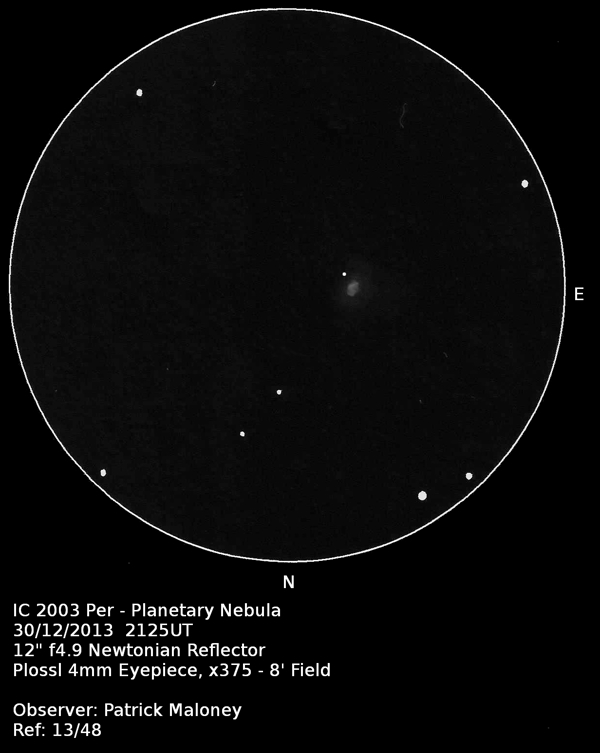An open cluster and a planetary nebula in Perseus
November 2021 - Nebula and Cluster of the Month
During November in the northern hemisphere, the Milky Way stretches from horizon to horizon, passing through the zenith. This view provides us with access to some of the best the northern Milky Way has to offer.
On these nights, Perseus hangs directly overhead, with its bright, naked-eye cluster of hot B-type stars centred on α Persei (Mirfak). A beautiful sight in binoculars, this stream of young, energetic stars lies right along the line of the Milky Way and defines it for many observers. Usually known as the α Persei Cluster, it also bears the designations Melotte 20, Collinder 39, Lund 106, OCl 392 and C0318+484!
This object, wonderful though it is, is not our open cluster of the month. That honour falls to NGC 1245, which lies 3° to the southwest of α Per. This fine open cluster was identified by our hero, William Herschel. He first recorded it on 11th December 1785, describing it as A beautiful compressed and rich cluster of small and large stars, 7 or 8’ diameter, the large stars arranged in lines like interwoven letters.

Modern catalogues usually grant it a diameter of 10’, though the vast bulk of the cluster is contained easily within Herschel’s smaller estimate. Researching this object in different reference works has thrown up some interesting (and not very edifying) discrepancies. I used the Deep-Sky Guide to Uranometria 2000.0, Archinal & Hynes’ (A&H) Star Clusters, the Night-Sky Observers’ Guide, Luginbuhl & Skiff’s (L&S) Observing Handbook and Catalogue of Deep-Sky Objects and Swann’s Atlas of Open Star Clusters (Volume 1). All agreed on an overall magnitude of 8.4 and a diameter of 10’. Most agreed that the brightest star is magnitude 11.16, apart from A&H, who give 12.0. All apart from L&S give a star count of 200, L&S gives 156. The real differences come in the Trumpler classifications, which are given variously as II2r, III1r and III3r. It’s worth pointing out that these classifications can be somewhat subjective. For what it’s worth, my own stab at classifying it would be as a III2r! At least everyone agrees that the cluster is rich.
On a good night, NGC 1245 is visible as a small, hazy patch in binoculars. A 4” (10cm) telescope will show a larger hazy patch with some twinkles. An 8” (20cm) will reveal about 50 stars, a 12” (30cm) maybe 75-100. Move up to a 16” (40cm) and the full glory of the cluster is apparent, with stars ranging from magnitude 11 (or 12) down to around 16. Many observers note that the cluster appears to consist of a circular ring of stars with a relatively empty centre.
My observation, made with a 12” reflector on a not particularly good night, reads: A medium-sized cluster of mostly very faint stars. Barely visible in the lowest power eyepiece. Brighter members form a triangular shape but the fainter members fill this out to a circle. There are many stars, probably hundreds. Many of the fainter stars were unresolved.
In 2003, Annapurni Subramaniam reported in the Bulletin of the Astronomical Society of India (Vol. 31, p. 49-64) on a photometric survey of 196 stars within NGC 1245, which amongst other things indicated a distance of 3kpc (9800 light-years). At this distance, 10’ would translate to an actual diameter of about 28 light-years.
Staying within the boundaries of Perseus, we now move on to the nebula of the month. IC 2003 is a small but relatively bright planetary nebula, most sources agreeing on a magnitude of around 11.5. It is located halfway between ζ Per (magnitude 2.9) and ξ Per (magnitude 4.0), being almost exactly 2° from each.
IC 2003 was discovered on 18th January 1907 by Thomas Espin, the great double star observer and friend of our own Rev. T. W. Webb. It was first published by him in the Monthly Notices of the Royal Astronomical Society in 1907 and made its way into the Second Index Catalogue of Nebulae Found in the Years 1895 to 1907 in 1908. The description in the IC is Pretty bright, exceedingly small, a little elongated north-south, a 13th magnitude star 4” north, a 12th magnitude star south preceding 18”
.

The nebula is admittedly small, measuring about 7” in diameter. Under low magnification, the object is effectively stellar and looks like the brighter component of a double star, with a 13th magnitude companion. It can be identified through the use of an OIII filter, to which it responds well.
It is immediately recognisable under medium power (say x150), but when I observed it, I pushed the magnification up to x375. At that power, it looks oval. Faint outer nebulosity could be seen. When viewed through the OIII filter, it appeared a little uneven in texture.

This is a lovely little object and if you have the ability to employ magnifications up to 300x–400x, then it’s quite interesting to see how it begins to resolve itself. If you’ve never bagged an IC planetary nebula before, this is a relatively easy one to start with.
Patrick Maloney (DeepSkyBagger@gmail.com)
| Object | RA | Dec | Type | Magnitude |
|---|---|---|---|---|
| NGC 1245 | 03h 14m 41s | +47° 14’ 21” | Open cluster | 8.4 |
| IC 2003 | 03h 56m 22s | +33° 52’ 33” | Planetary nebula | 11.5 |